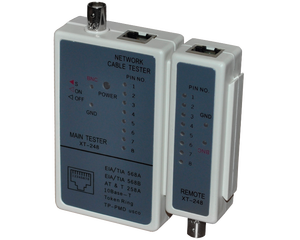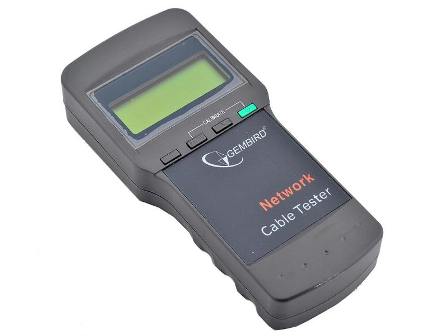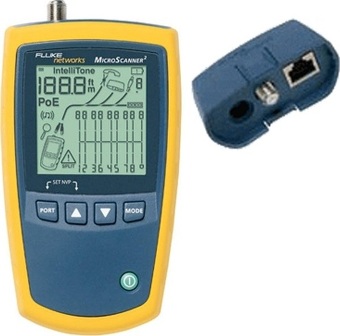Categories: Electrical Reviews
Number of views: 23589
Comments on the article: 0
Cable Testers - An overview of cable testers
 To check the status of cable lines or cables use cable testers. They are electronic devices, usually consisting of two parts. These devices are different, and some of them allow you to determine the characteristics of cable lines or cables. There are three classes of cable testers on the market today:
To check the status of cable lines or cables use cable testers. They are electronic devices, usually consisting of two parts. These devices are different, and some of them allow you to determine the characteristics of cable lines or cables. There are three classes of cable testers on the market today:
-
For basic cable inspection;
-
For qualification of cable systems;
-
For certification of cable systems.
According to the type of cable tested, the devices are divided into:
-
Testers for optical cables;
-
Testers for coaxial cables, telephone cables, twisted pairs.
The latter are versatile, with their help you can test completely different types of electrical cables, widely used today.
The most important parameters that can be measured using a cable tester are:
-
Length of cable;
-
The layout of the conductors in the cable;
-
Amount of attenuation;
-
Crosstalk at the near end of the cable line - NEXT;
-
DC resistance value on a copper cable;
-
Return Loss Level - Return loss.
In its simplest form, a cable tester with LED indicators is able to show minimal compliance cable characteristics specified requirements. This type of tester allows you to more efficiently perform cable or simple wiring, and immediately identify malfunctions, if any.
Of course, the functionality of simple testers will not allow you to measure the distance to the place of damage, and will not detect split pairs. However, a simple tester will be able to check whether the wires are connected correctly and identify typical mechanical damage (short circuit or open). Of course, there is no need to talk about checking optical cables here.

An example of a simple cable tester is the cable tester. RJ-45 + BNC (HT-C003) (TL-5248) by REXANT. This device is suitable for testing cables based on twisted pairs, as well as coaxial cables. It includes two blocks, one of which is a transmitter, the second is a receiver. The transmitter and receiver are connected to the ends of the cable via BNC or RJ-45 connectors.
The device checks whether crimping is performed correctly, whether there is an open circuit, if there is a short circuit in the line, whether the screen is intact, if we are talking about checking a shielded twisted pair. On both units there is an LED display showing the test result. Case material - shockproof plastic.
More complex testers have advanced functionality - they have tone generators that allow you to identify split pairs.
Modern testers equipped with displays are able to find all kinds of errors in wiring diagrams. Here it is possible to detect split pairs, and find out the length of the cable line, as well as measure the distance to a short circuit or to a break, and even determine what type of socket is installed on the other side of the line (network or telephone).
Cable qualification devices (qualifying testers) were originally launched by Fluke Networks. Testers of this class can determine the speed capabilities of cable and cable systems, whether the systems can operate at higher speeds. Each instrument of the qualifying class has the functions of measuring the parameters of Return loss and NEXT, as well as attenuation in the cables.
As you can see, devices of this class can not only “ring” the cable, but also much more. For specialists in the IT industry, these devices will become, without exaggeration, indispensable assistants, without the need to purchase an expensive cable analyzer.
Today, several manufacturers of cable testers of a qualifying class are widely represented on the country's market, these are: Ideal Industries, JDSU and Fluke Networks.

A simple example of a tester for qualification is NCT-3, - Portable Digital LAN Tester for RG-45, RG-58, RJ-12/11 from Gembird. This device can easily detect problems in network cables of categories 5e and 6e, as well as in coaxial or telephone lines. Short circuit, open circuit, crossover connection, short circuit of conductors - all this can be detected by the tester.
The device will measure the length of the wire and set the distance to the open. A quick diagnosis of the problems of local networks is by no means a problem for a master who has this or a similar device in his arsenal. Measurement accuracy reaches 97% due to calibration.
The first device of the certification class was released in 1993, and was released by the American company Microtest, which later (in 2001) was bought by Fluke Networks.
The main task of these testers is to verify how one or another cable system complies with international standards, because the certification stage is integral to the design and installation of any structured cable system. Cable categories and classes are defined by industry standards for TIA and ISO.
The cable certification tester allows you to fully test the cable, and displays the frequency dependencies of various parameters that are important for TIA and ISO. Information is displayed in the form of graphs on the screen of the tester, and the specialist in the form of these graphs understands what and where to improve in the line. If the user is not a specialist, then the tester will still indicate whether the result of the test is Pass or Fail.
-
Pass - the cable is fully operational, the condition is excellent, all tests passed successfully;
-
Fail - there are malfunctions.
A certification device usually also has the ability to print measurement data in a standardized form, so that later on the printout, it would be possible to approve the commissioning of the measured communication line in accordance with the law. Such testing is universal from the point of view of the layman, because there is no binding to network technology.
Suppose a category 6 cable is capable of transmitting data at a speed of 10 Mbit / s to 10 Gbit / s, and a category 5e cable is capable of transmitting from 10 Mbit / s to 1 Gbit / s. If the test result is “Fail,” then diagnosis is required. A cable tester with a diagnostic function will show and allow you to understand (according to the NEXT and Return Loss tests) whether the connectors are in the problem or directly in the cable.

An example of a device with very broad functionality is Microscanner2 Cable Tester (FLN-MS2-100) from Fluke. The large LCD screen displays the connection diagrams, as well as the cable identifier, its length, as well as the distance to the location of the fault.
The tester can check all major types of conductors, including RJ45, RJ11 and coaxial without additional adapters. There is an IntelliTone tone generator that allows you to locate cables or pairs of conductors by supplying analog and digital tones. The VDV Service Definition feature enables the recognition of advanced communication services, including POTS, 10/100/1000 Ethernet, and PoE.
MicroScanner2 class testers dramatically simplify the process of checking cables for voice, data and video, and high-quality cable systems are now more effective than ever.
Many diagnostic tasks are solved quickly: is there a voltage in telephone networks? What is its polarity? Is there an Ethernet switch at the opposite end? Is PoE available? MicroScanner2 simultaneously considers all these factors and offers the specialist high-quality visual tools for checking the most popular video, data and voice transfer services today.
See also at bgv.electricianexp.com
:
